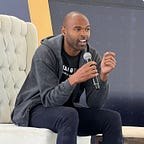Pay attention: The global financial crisis of our lifetimes is here.
The inflation we are just starting to notice started back in 2008 when central banks around the globe slashed interest rates to all-time lows, many going into negative rate territory.
We all seem to have forgotten about the Troubled Assets Relief Program (TARP), which was at the time the largest bail-out the world had ever seen with an authorized $700 billion of stimulus. The Federal Reserve cut interest rates to the floor and entered full-on crisis mode.
With the economy reeling and interest rates already at the floor, the government turned to quantitative easing. This allowed the Fed to purchase trillions of dollars worth of distressed assets.
We printed tons of money to stop the financial world from ending and central banks worldwide followed suit. The world took a collective sigh of relief as housing prices steadily went up and the economy seemed to recover.
But we often conflate a rising stock market and housing prices with a strong economy. Asset inflation makes the wealthy even wealthier so we never hear complaints about these early warnings of inflation. This is misguided. An inflation-fueled rise in the prices of pretty much every asset worldwide is really, really bad.
Then came the COVID-19 pandemic to create the perfect storm of an economic collapse that is now upon us. Politicians decided to shut down the global economy in order to save human lives. Would that extremely loose monetary policy of the past decade be all for naught?
No. We decided to step on the gas even harder. Within a year, the stimulus pumped into the global economy was more than triple what we spent during the 2008 financial crisis.
The US avoided hyper-inflation because every country with its own currency printed money right along with us. In Japan, their COVID-19 fiscal stimulus as of May 2021 was a staggering 53% of their GDP.
Of the nearly $10 trillion of US stimulus dispersed during the pandemic, less than 20% went to the stimulus checks for everyday Americans, and income benefits such as extra unemployment benefits, delayed student loans, or food assistance. The vast majority, more than 80% of the dollars spent, have gone to corporations and the wealthiest Americans. The Federal Reserve has purchased over $4 trillion in assets, pushing prices in the stock, housing, cryptocurrencies, collectible art, precious metals markets to all-time highs.
That is how you cause unstoppable inflation.
Although most of the stimulus money has gone towards asset inflation and increasing the already untenable global wealth gap, if you do that long enough, eventually you’re going to start to see consumer inflation as well.
What happens when you have all-time-high asset prices around the world, zero-percent interest rates, and consumer index inflation soaring past 7%?
You either raise interest rates and cause a massive collapse in asset prices, or you allow hyperinflation to occur. There are no other choices.
The Federal Reserve and other central banks always play the role of market cheerleader, no matter how bad things are getting, so you have to read between the lines. When the Federal Reserve recently announced plans to raise rates, that should have been a major red flag to investors, despite Federal Reserve Chair Jerome Powell pretending that the rate hike was a sign of a strong economy.
Raising rates due to inflation is always a bad omen, especially when rates have been their lowest in recorded history for over a decade.
Powell now has to take the punch bowl away. When everyone has been drunk off liquidity for over 13 years, how will the economy handle this sudden sobriety? Markets clearly will drop as interest rates rise, but the chorus is already singing that all is fine, nothing to worry about here!
They are wrong.
An unprecedented 97 million people have already fallen back into poverty during the pandemic. Being poor has been a death sentence during COVID primarily because although we so often accuse them of being lazy freeloaders, we finally realized that (surprise!) low-income workers are actually essential to society and the economy. We clapped for them as heroes daily but during the pandemic poor people made the least amount of money while dying the most.
Economic winter is coming and the poorest Americans are living on the streets.
We are on the verge of an economic and social disaster that no one is talking about it. It is time to sound the alarm.
“When the music stops, in terms of liquidity, things will be complicated. But as long as the music is playing, you’ve got to get up and dance.”
Former CEO of Citibank in July 2007.
We are going to have to raise interest rates and asset prices will collapse. There is no easy solution. If we don’t raise interest rates, we will see massive inflation of the dollar and the potential fall of our entire financial system.
To counter the effects of falling asset prices we must provide direct and unconditional stimulus to working-class Americans. If we don’t do this, we will see a wave of evictions, job loss, hunger, and economic collapse that rivals the Great Depression.
We cannot waste our time and energy giving money to corporations. Nearly $100 billion in COVID-19 stimulus designated for businesses was stolen. No programs, no bureaucracy, no corporate welfare, just give people money. If poor people have money, they will spend it because their needs are immediate. If corporations have money, they will use it to buy back shares and wait for more clarity. The wealthy can afford to be patient.
Nations need a quality safety net when disaster strikes. COVID-19 has exposed that throughout the world, government programs have failed to take care of the most vulnerable populations. Put money directly into the hands of the people so that they can take care of themselves. We cannot afford to get this wrong.
